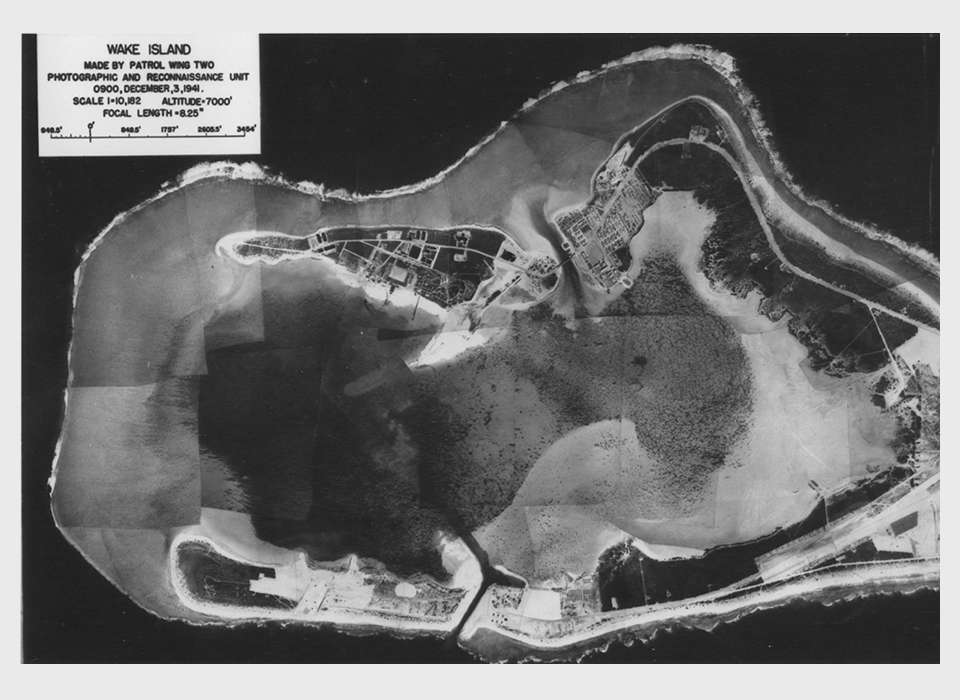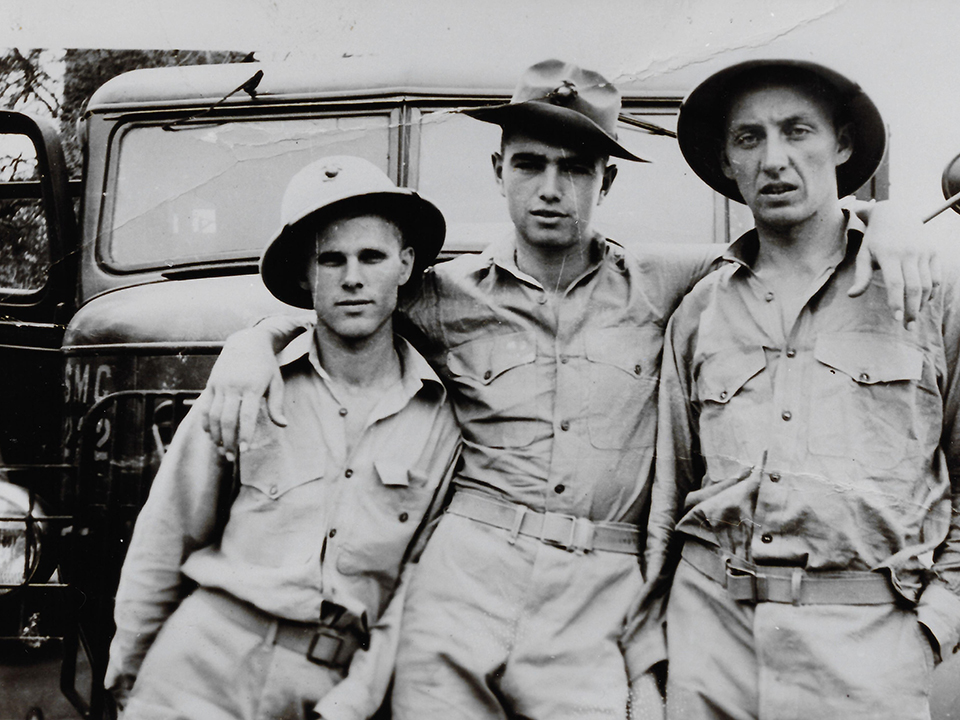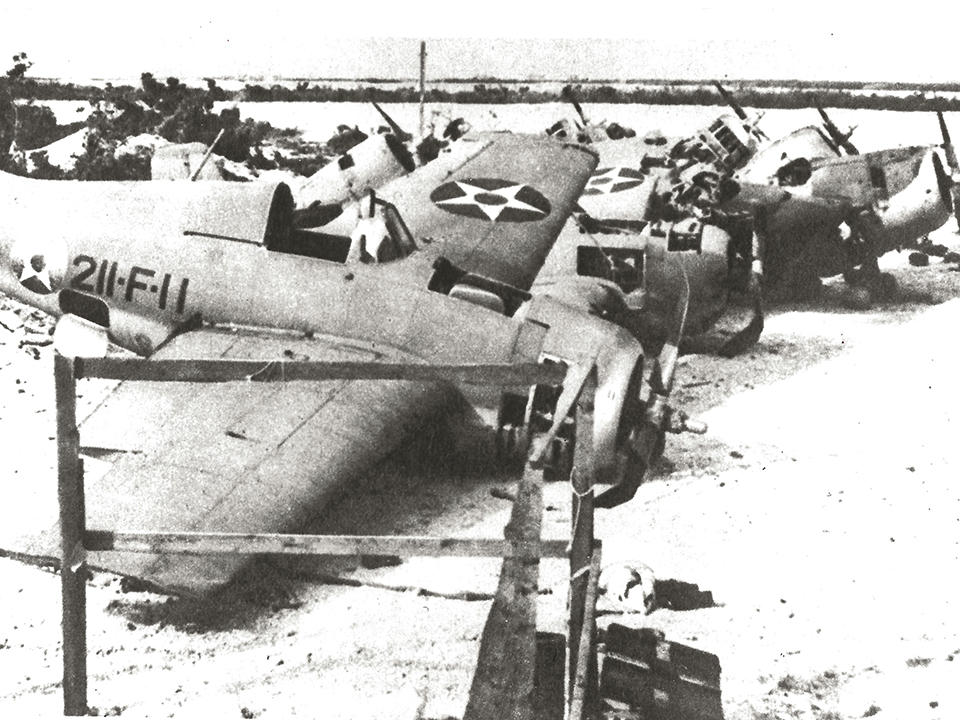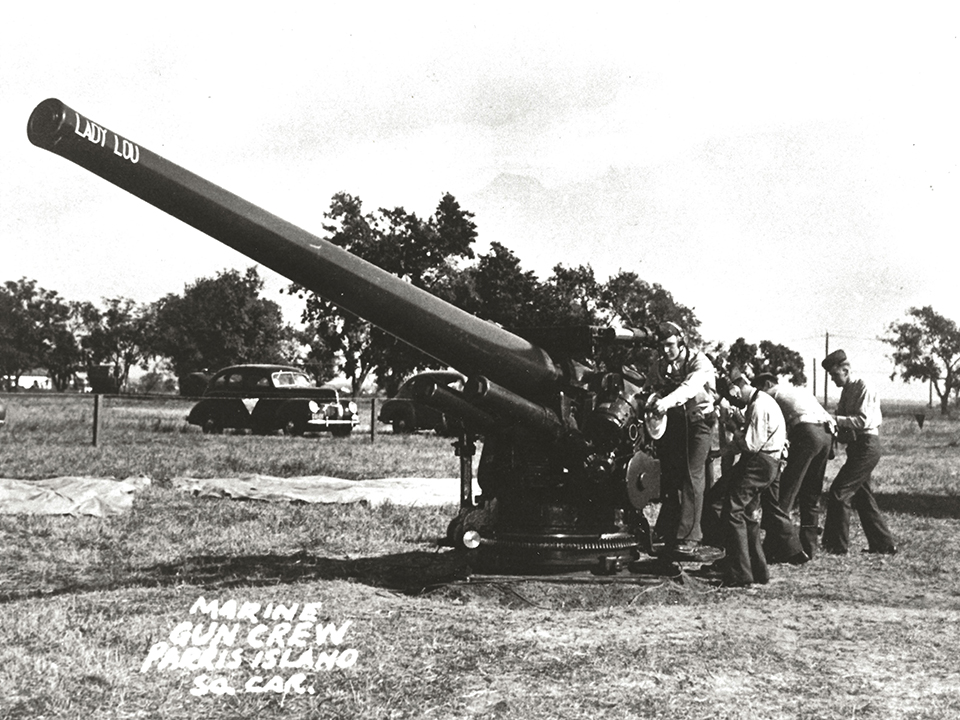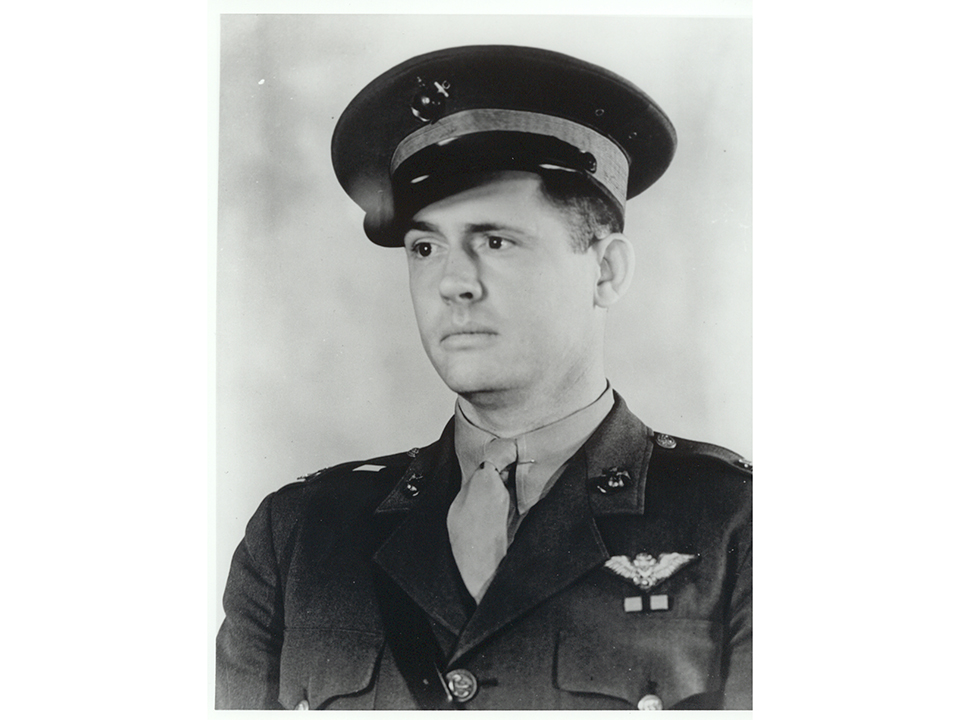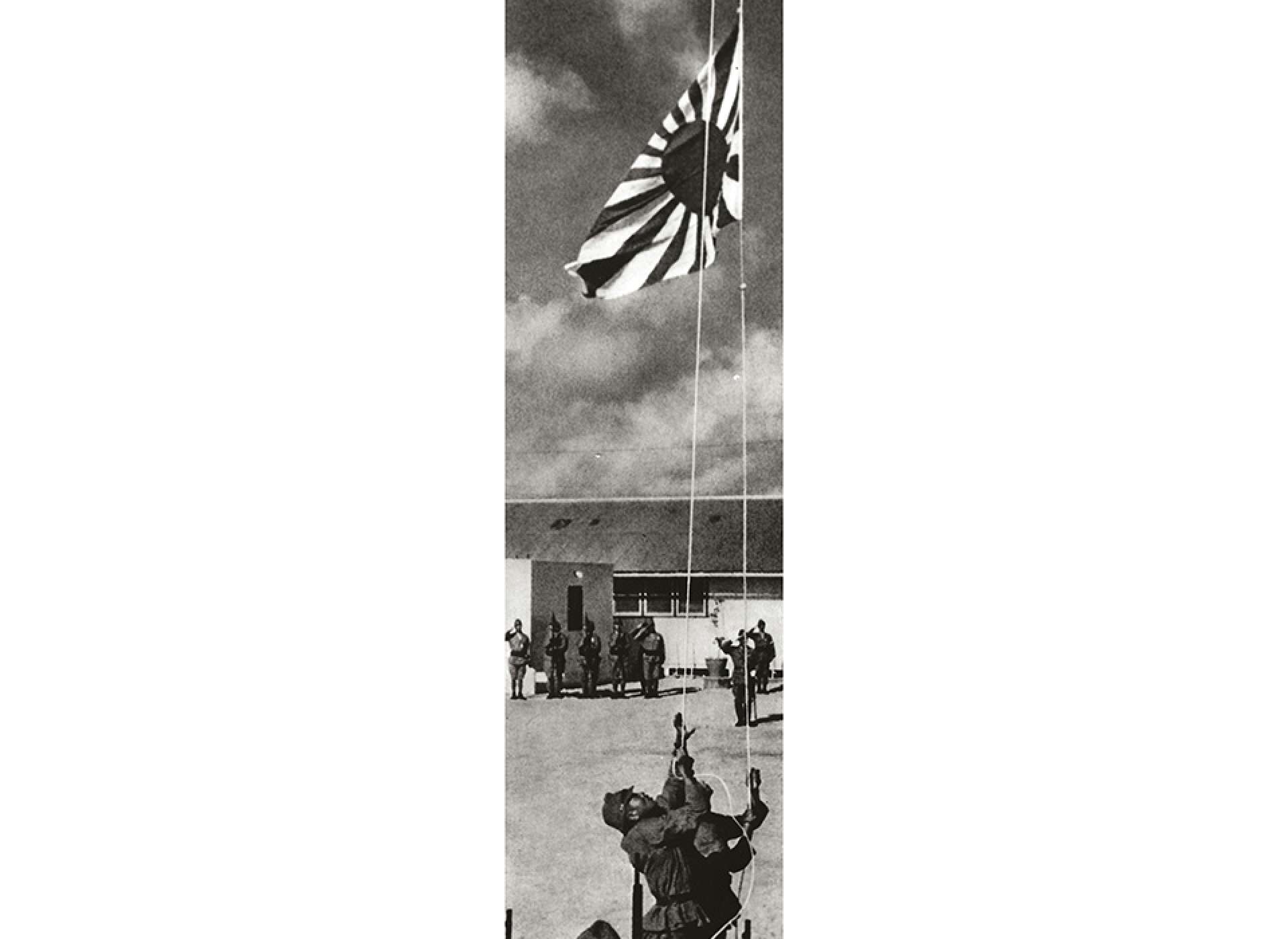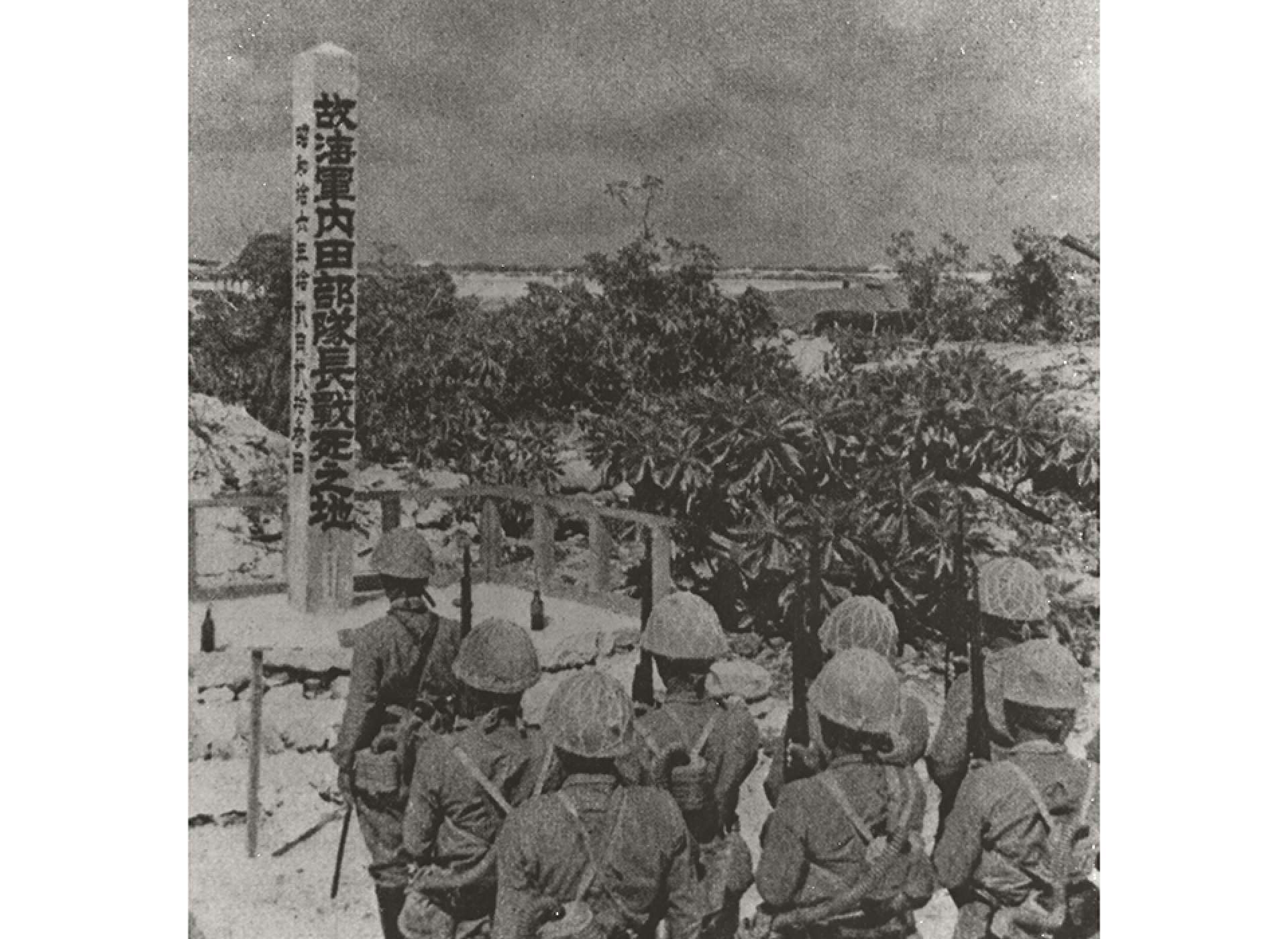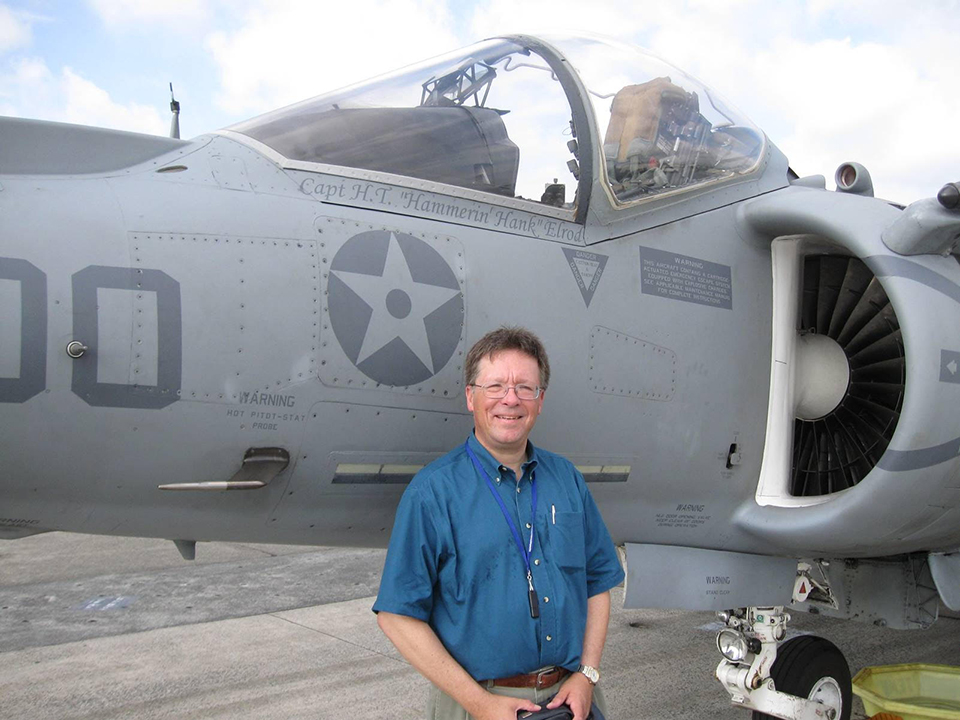Top Image: The PBYs of VP-22 took this composite aerial photograph of Wake Island during a brief visit on December 3, 1941—just five days before Japanese bombers first pounded the atoll. The roads and installations built by Contractors Pacific Naval Air Bases are clearly visible, including the triangular airfield at the apex of the main islet at lower right. Image courtesy of the National Archives and Records Administration.
When World War II abruptly gripped the United States in its deadly embrace, a people seething with anger struggled to avoid being sucked into a vortex of gloom. The stunning Japanese carrier raid of December 7, 1941 on Pearl Harbor turned out to be just the first in a succession of blows that threatened to sweep the American military out of East Asia and the Central Pacific. Although President Franklin D. Roosevelt’s administration endeavored to conceal the full extent of the US Pacific Fleet’s losses, no amount of censorship could conceal the fact that Japan had gained the upper hand.
In a somber “Fireside Chat” on December 9, FDR confessed:
So far, the news has been all bad. We have suffered a serious set-back in Hawaii. Our forces in the Philippines, which include the brave people of that Commonwealth, are taking punishment. . . . The reports from Guam and Wake and Midway islands are still confused, but we must be prepared for the announcement that all these three outposts have been seized.
Three days later, however, American newspapers surprised their readers with jubilant headlines announcing a victory at Wake Island—a small, undermanned outpost situated 2,000 miles west of Oahu. Early on December 11, the atoll’s garrison repulsed an attempted amphibious assault, sinking two enemy warships. Most of Wake’s defenders were US Marines, and the commandant of their corps, Major General Thomas Holcomb, promptly publicized that fact. “A cheery note comes from Wake,” he informed Secretary of the Navy Frank Knox, “and the news is particularly pleasing at a time like this.”
The United States took possession of Wake Island at the commencement of its flirtation with imperialism in 1898. Devoid of human inhabitants or potable water, the place hardly seemed worth the trouble. From the sky, the atoll resembled a broken wishbone, with its three misshapen islets named Wake, Wilkes, and Peale. As Japanese American relations simmered with increasing heat four decades later, however, Wake Island’s low-lying, two-and-a-half square miles of coral sand and rock acquired strategic value. A report filed by the US Navy’s Hepburn Board in late 1938 recommended the atoll’s conversion into a base for landplanes, seaplanes, and submarines as part of the Hawaiian Naval Coastal Frontier, which would screen Pearl Harbor from Japanese attacks emanating from the southwest.
The lingering effects of isolationism kept Congress from allocating the funds necessary to act on the Hepburn Board’s vision until the eleventh hour. In January 1941, General Superintendent Nathan D. “Dan” Teters and his 76-man “Pioneer Party” from Contractors Pacific Naval Air Bases finally landed at Wake Island to start turning the Hepburn Board’s recommendations into reality. Within 11 months, 1,146 of these civilian construction workers—called “Contractors” by the Navy—were toiling in almost every corner of the atoll, erecting seaplane facilities and a complex of barracks and other buildings. They also used their heavy excavating and grading equipment to provide Wake with a road network and a triangular airstrip.
As Admiral Husband E. Kimmel, the commander of the US Pacific Fleet, pored over his maps at Pearl Harbor, he realized that every construction project completed by Teters’ Contractors increased the likelihood of an attack on Wake if hostilities broke out with Japan. In mid-August 1941, Kimmel started drawing on his limited resources to provide the atoll with a garrison. The admiral intended to defend Wake with 1,851 US Marines, 760 sailors, two fighter squadrons, one PBY squadron, half a squadron of dive bombers, and half a squadron of torpedo bombers.
Privates First Class Clifton H. Lewis, LeRoy N. Schneider, and John E. Pearsall of the Wake Island Detachment, 1st Defense Battalion, photographed in 1941 before shipping out from Hawaii. The three buddies survived the sixteen-day siege and then went on to score a moral victory with nearly 96 percent of their fellow Wake Marines by withstanding a hellish three-and-a-half years as Japanese POWs. Image by the Gregory J.W. Urwin Collection.
By December 4, 1941, the atoll’s American garrison numbered only 524 officers and men— 449 Marines, 69 sailors, and a six-man radio detachment from the US Army. Three hundred and eighty-nine Marines belonged to the Wake Island Detachment, 1st Defense Battalion. That was only a third of the number needed to properly man the twelve 3-inch antiaircraft guns, six 5-inch seacoast guns, six searchlights, eighteen .50-caliber antiaircraft machine guns, and thirty .30-caliber machine guns that Kimmel sent to defend the atoll. The other 62 Leathernecks belonged to Marine Fighting Squadron (VMF) 211, which brought 12 Grumman F4F-3 Wildcat fighters to operate from Wake’s pounded coral runways.
Major James Patrick Sinnott Devereux arrived on Wake on October 12, 1941, to take charge of the 1st Defense Battalion Marines. As the battalion’s executive officer at San Diego and then Pearl Harbor, Devereux ruled the rank and file with an iron rod. His Leathernecks detested the very sight of him, and they tagged him with a nasty nickname based on his first three initials—“Just Plain Shit.” Conscious that Wake could become a combat zone at any moment, Devereux worked his men 12 to 16 hours a day, seven days a week. Unlike the Contractors, who possessed the best modern construction equipment, the Marines received only picks and shovels to chip gun emplacements, command posts, and other emplacements out of Wake’s hard coral shell. In addition to cracking the whip over the Wake Island Detachment, Devereux supervised the atoll’s other military personnel until November 28, when Commander Winfield Scott Cunningham, a seasoned Navy aviator, arrived to assume command of the newly christened Wake Naval Air Station.
Major James P.S. Devereux, the commanding officer of the Wake Island Detachment, 1st Defense Battalion, was feared and despised by his enlisted men, but his inspired tactics on December 11, 1941, resulted in the repulse of the first Japanese landing attempt on the atoll. This photograph, taken while Devereux was a POW in China in late February 1942, appeared in a Japanese propaganda magazine. Image by the Gregory J.W. Urwin Collection.
Around 6:40 a.m. on December 8, 1941, the Army radio trailer at Wake’s airfield received an uncoded emergency message from Pearl Harbor, located to the east of the International Date Line, where it was Sunday morning, December 7: “SOS ISLAND OF OAHU ATTACKED BY JAPANESE DIVE BOMBERS. THIS IS THE REAL THING.” As a flustered field musician bleated a fractured version of “Call to Arms” on his bugle, Marine artillerymen and machine gunners boarded trucks and roared off to their battle stations.
At 11:58 a.m., 27 Japanese medium bombers that had taken off at dawn from the Marshall Islands burst out of a cloud bank just south of Wake’s airfield at an altitude of 2,000 feet. The atoll’s defenders had only seconds to react, but they hesitated momentarily, mistaking the enemy planes for an expected flight of American B-17 bombers from Hawaii. The Japanese caught eight of VMF-211’s Wildcats on the ground and quickly turned seven of them into flaming wrecks, while also killing or wounding half of the squadron’s personnel.
A captured Japanese photograph of the graveyard of VMF-211’s Grumman F4F-3 fighters taken after the fall of Wake Island. The Japanese destroyed seven of these planes on the ground during the atoll’s first air raid on December 8, 1941, but Captain Elrod flew the Wildcat in the foreground three days later when he sank a Japanese destroyer with a 100-pound bomb. Image by US Marine Corps.
Certain that the enemy would strike again, Wake’s garrison nerved itself for a siege. More than 400 Contractors volunteered to assist their fellow Americans in uniform. One hundred and eighty-six joined Marine gun crews. The others provided essential support services, using their power tools to strengthen Marine strongpoints, assisting with airplane repairs, belting machine gun ammunition, filling sandbags, and delivering hot, cooked meals to the atoll’s far-flung battle stations.
The Japanese subjected Wake to 12 more air raids between December 8 and 19 with medium bombers and mammoth flying boats, but they never caught the atoll’s defenders flat-footed again. Mounting plane losses and damage to those that returned to base could not faze the Japanese airmen’s overconfidence, and they reported that they had neutralized Wake’s defenses by December 10. With apparently perfect timing, Rear Admiral Sadamichi Kajioka appeared off Wake Island’s south shore early the following morning with a small flotilla called the Wake Invasion Force—three light cruisers, six destroyers, two transports, two patrol boats, and two submarines with 450 troops from the Japanese Special Landing Forces (SNLF).
As Kajioka’s ships bore down on Wake, Major Devereux realized that he was not only outgunned, but that the three cruisers outranged his six 5-inchers. His only chance was to play possum and draw the enemy into pointblank range so his gunners could not miss. The light cruiser Yubari, Kajioka’s flagship, closed to 8,000 yards before going into its firing run, and the rest of the flotilla followed suit. The Marines found not being able to fight back almost unendurable. A corporal manning the field phone switchboard in Devereux’s command post heard one 5-inch battery commander vent, “What is the little son-of-a-bitch doing? Goddam it! We’ve been hitting targets at Pearl Harbor at 12,000 yards and the bastards are in to 7,000! What the hell is he waiting for!” Despite the maddening stress, Devereux’s Marines feared him too much to defy his orders.
US Marines crew a 5-inch. .51-caliber naval gun installed at Parris Island, South Carolina, for training purposes. Castoffs that once served as the secondary batteries on US Navy cruisers and battleships, six of these obsolescent weapons belonged to the Wake Island Detachment’s three seacoast batteries—but they packed enough punch to rout a Japanese task force on December 11, 1941. Image by Parris Island Museum.
When the Yubari turned into its third firing run just 4,500 yards offshore, Devereux uttered the following command in a dispassionate voice: “O.K. Open fire.” In short order, his gunners sank one Japanese destroyer. They also hit the Yubari and several other ships. Kajioka and his subordinates immediately turned tail and raced out of the American ambush, or so they thought. With only four Wildcat fighters left in commission, VMF-211 flew 10 sorties against the fleeing Japanese, harrying its opponents with strafing machine guns and 100-pound bombs. A lucky hit from one of the latter caused a second destroyer to explode and go to the bottom. Later that day, a patrolling Wildcat sank a Japanese submarine that dared to surface 25 miles off the atoll.
Captain Henry T. Elrod, VMF-211’s leading pilot, received a posthumous Medal of Honor for shooting down two Japanese medium bombers on December 10, 1941, sinking a Japanese destroyer on December 11, and rallying his comrades in the ground fighting that claimed his life on December 23. Elrod’s comrades referred to him as “Hammering Hank.” Image by US Marine Corps.
At a cost of two fighters damaged and five Marines slightly wounded, Wake’s defenders had routed the Japanese in America’s first tactical victory of the Pacific War. The news electrified a nation reeling from Pearl Harbor and other setbacks. Following the example of newspaper pundits and radio commentators, President Roosevelt added his voice to a swelling chorus of triumph, telling millions of his fellow citizens on December 12 that the Wake garrison was “doing a perfectly magnificent job.”
While Americans rejoiced, the Imperial Japanese Navy rushed to restore its tarnished pride. It reinforced the Wake Invasion Force with four heavy cruisers, two more destroyers, two minelayers, one seaplane tender, and two veterans of Pearl Harbor—the aircraft carriers Soryu and Hiryu. Kajioka’s landing force also received nearly 1,600 additional SNLF troops to ensure Wake’s fall. If they were not enough to do the job, the admiral resolved to run six destroyers aground and commit their crews armed with rifles to the ground fighting.
The Soryu and Hiryu’s air groups shot down VMF-211’s remaining two fighters on December 22, but Admiral Kajioka refused to square off against Devereux’s 5-inchers in another gunnery duel. Dispensing with the formality of a preparatory barrage, Kajioka flung the 900 SNLF troops in his first wave against Wake’s south shore in the pre-dawn darkness of December 23.
The Marine Corps indoctrinated its members to believe that they were riflemen first. As the SNLF men landed at various points, Devereux’ Leathernecks left their gun pits to meet the invaders as infantry. The grounded pilots of VMF-211 and their surviving ground personnel did likewise. During more than 11 hours of close combat, the Marines, assisted by several dozen sailors and Contractors, inflicted heavy losses on the Japanese. At one point, they wiped out a beachhead containing nearly 100 SNLF troops. Elsewhere, they delivered an effective counterattack against other Japanese trying to overrun the airfield, forcing back the enemy over 900 yards.
Unfortunately, Commander Cunningham had received notification of the recall of an American relief expedition that had been dispatched by the Pacific Fleet. With communications disrupted by SNLF men cutting American field phone lines, Major Devereux assumed that most of his strongpoints on Wake’s south shore had been overrun. Cunningham reluctantly issued orders to surrender, and Devereux bravely headed toward the sounds of the fighting to make sure they were obeyed.
-

Japanese SNLF troops raise their country’s flag over Wake Island to celebrate the atoll’s capture on December 23, 1941. Image by US Marine Corps.
-

Japanese SNLF troops salute the grave of their company commander, one of many of the invaders killed by the atoll’s defenders on December 23, 1941. Image by US Marine Corps.
The Japanese Navy sacrificed two destroyers, one submarine, 21 aircraft, and 900 to 1,000 lives to conquer Wake Island. Much to the enemy’s consternation, fewer than 100 Americans died during the 16-day siege—including just 46 Marines and three sailors.
The American news media would not know these details until the return of peace. Yet when the public learned on Christmas Eve, 1941, of Wake Island’s fall, it reacted surprisingly. Rather than mourn the atoll’s defenders, Americans feted them as heroes, characterizing their stand against superior odds as a modern-day Alamo and proof that their country’s sons possessed sufficient courage to crush Japan as soon as the republic could mobilize its numbers and economic power. Wake became a potent American rallying point. It inspired Paramount Pictures to produce the first feature film of the war that showed American fighting men in combat. Released in late August 1942, Wake Island would boost both Marine recruiting and war bond sales.
In a letter dated March 10, 1942, Commandant Holcomb summed up what the Wake saga meant to Americans who weathered World War II:
“Wake Island began the war magnificently for the Marine Corps, and America found that the old soldierly virtues are still embodied in its fighting men. . . . Out of such actions as this a people’s strength and ultimate victory must come. America remembers Wake Island and is proud. The enemy remembers Wake Island and is uneasy.”
Meet the Author
Gregory J.W. Urwin is a professor of history at Temple University, a former president of the Society for Military History, a Charter Member of The National WWII Museum, and a prize-winning author. He has written or edited nine books, including two on the Wake Island saga—Facing Fearful Odds: The Siege of Wake Island (1997) and Victory in Defeat: The Wake Island Defenders in Captivity, 1941-1945 (2010). His current book project is titled “When Freedom Wore a Red Coat: The British Invasions of Virginia, 1781.”
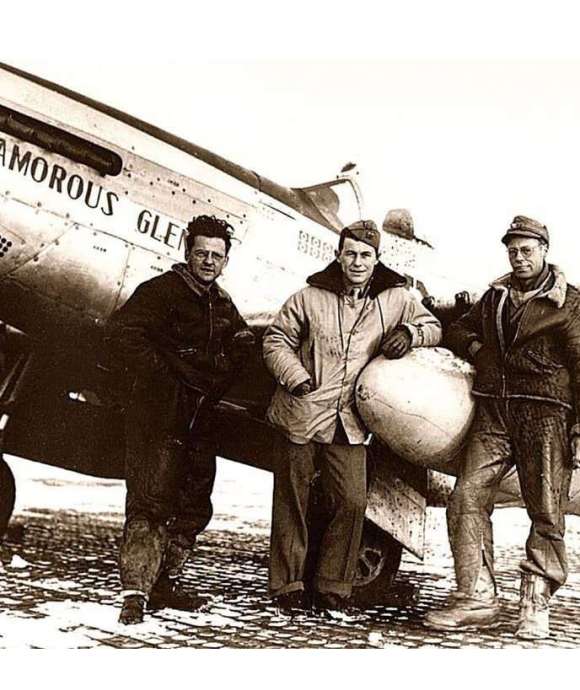
Chuck Yeager: WWII Fighter Ace and Record Breaking Test Pilot
Brigadier General Charles “Chuck” Yeager was best known as the first man to break the sound barrier, but during World War II Yeager was a decorated fighter ace.
Cite this article:
MLA Citation:
APA Citation:
Chicago Style Citation:
